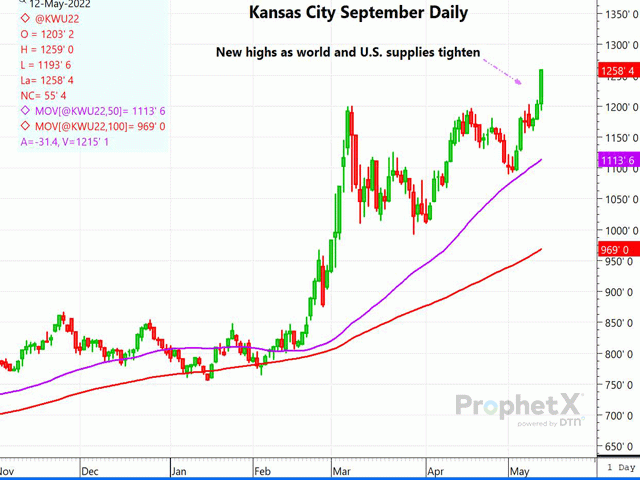USDA Reports Review
Tightening US and World Wheat Supplies Send Wheat Futures Prices to Near Limit Gains
The highlight of the May 12 USDA World Agricultural Supply and Demand Estimates (WASDE) report turned out to be wheat, featuring a greater-than-expected drop in both U.S. and world stocks, sending all three wheat futures markets briefly up the daily limit, before setting back. Changes in the May WASDE soybean numbers were mostly neutral, with corn stocks bullish for new crop on falling yield estimates, but neutral overall.
Read below for an in-depth breakdown of wheat, soybeans and corn:
WHEAT
All wheat production in the U.S. was pegged at 1.729 billion bushels (bb), with a 46.6-bushel-per-acre (bpa) yield, and lower than the average trader estimate of 1.791 bb. That's 83 million bushels (mb) higher than last year's 1.646 bb crop. Hard winter wheat was lower than expectations, at 1.174 bb, and 104 mb lower than last year, with Kansas at 271 mb, Oklahoma at 60 mb and Texas at just 41.6 mb. The hard red winter crop fell to 590 mb compared to 749 last year, as the southwestern and Southern Plains have endured drought conditions for months. Abandonment for winter wheat was reported to be the highest since 2002, with Oklahoma and Texas comprising the majority of that. Soft red wheat was a bit lower than expected, with white wheat making a nice rebound to 230 mb compared to last year's 167 mb and the average trade estimate of 199 mb. Spring wheat was estimated to be 187 mb higher than last year, while using trend yields. However, that is a moving target, with very late planting in key states and acres likely to fall sharply from here.
Old-crop ending stocks of wheat were a lower-than-expected 655 mb, as 2021-22 export sales were increased by 20 mb, with ending stocks about 29 mb less than the average guess. For 2022-23, ending stocks were dropped to 619 mb, down 36 mb, and that is the lowest in nine years. Feed and residual usage was lowered 20 mb to account for less feeding, and, despite the Russian-Ukraine war, exports were dropped 30 mb to 775 mb from the revised old-crop export number, to 775 mb. The USDA report gave no hint that the U.S would pick up lost Ukraine sales.
On the world front, global wheat production fell by 4.5 million metric tons (mmt) to 774.8 mmt (28.4 bb), and world ending stocks plunged to 267 mmt (9.8 bb), compared to expectations for 272 mmt, and down from 279.7 mmt (10.3 bb) a year ago -- the lowest stocks in six years. Ukraine production was estimated to be down 11.5 mmt to 21.5 mmt. Canada production was raised to 33 mmt compared to last year's drought-damaged crop of 21.5 mmt (790 mb). Russia's exports were pegged at 33 mmt (1.2 bb), with Ukraine falling to just 10 mmt and sharply lower due to the war. Perhaps one of the biggest surprises, which appears to have been ignored by the trading crowd, is the India wheat production number of 108.5 mmt (3.99 bb), with exports still pegged at a record-large 8.5 mmt despite reports that the crop was well down there due to extreme heat and that exports could be banned. Even the Indian government has production at just 105 mmt.
The season average farmgate price for wheat was raised a hefty $3.05 to $10.75 per bushel.
P[L1] D[0x0] M[300x250] OOP[F] ADUNIT[] T[]
The WASDE report was construed as bullish for wheat, with world and U.S. wheat supplies on a downward slide.
CORN
U.S. old-crop (2021-22) ending stocks were left untouched at 1.440 bb, while the trade was expecting 40 mb less than that. Corn production came out at 14.460 bb, down 655 mb from a year ago, with a 177 bpa yield, using a planted acreage of 89.5 million. Due to late planting in much of the Corn Belt, especially in the northwestern and Northern Plains, yield was dropped to match last year's record 177 bpa, down from the outlook's 181 bpa. New-crop corn feed and residual was lowered by 275 mb, and exports were dropped 100 mb to 2.4 bb due to the smaller crop. New-crop ending stocks for 2022-23 were lowered to 1.360 bb, slightly above trader expectations of 1.335 bb.
The average farmgate price was reported to be $6.75 per bushel.
On the world front, old-crop ending stocks came out higher than expected at 309.4 mmt (12.2 bb), about 4 mmt higher than the last WASDE and 3.7 mmt above trade estimates. South American corn production, despite the ongoing drought in central Brazil, were left unchanged at 116 mmt (4.52 bb) for Brazil and 53 mmt (2.08 bb) for Argentina. Traders had looked for a corn number of 113.9 mmt for Brazil and 51.7 mmt for Argentina. Argentina has 50% of its harvest left, with Brazil yet to harvest, so both of these could be overstated. Ukraine exports were dropped by a hefty 550 mb due to the war and port blockages, with production at 19.5 mmt (767 mb) compared to 42.13 mmt (1.66 bb) last year. China's corn imports were dropped by 5 mmt to 18 mmt, while China's corn production was also lowered by 1.5 mmt to 271 mmt (10.67 bb). New-crop ending world stocks were reported to be 305.1 mmt (12 bb), much higher than the 296 mmt that traders had expected, but down 4.3 mmt from 2021-22.
The world numbers on corn should have been bearish, but the market closed higher on other issues, including the horribly slow seeding pace in the U.S., the ongoing drought threat to Brazil's safrinha crop, and of course, the ongoing slow pace of Ukraine exports. New-crop December finished the day with strong gains on ideas that both yield and acreage could fall further on delayed planting and possible prevented planting and/or switches to soybeans in the North.
SOYBEANS
Old-crop soybean exports were raised by 25 mb on the stronger pace that USDA had estimated, sending ending stocks for 2021-22 to 235 mb -- down by 25 mb and the lowest ending stocks in six years. Traders had expected an even further fall to 222 mb.
New-crop production was estimated to be a record-large 4.640 bb with a yield of 51.5 bpa, and, using the same 91-million-acre planted area from the USDA intentions. For new-crop 2022-23, crush was increased by 40 mb on strong crush margins, to 2.26 bb, and exports were moved higher to 2.2 bb, sending ending stocks up to 310 mb -- exactly what the trade had estimated.
The season average farmgate price was increased to $14.40 from $13.25 previously. Soybean meal and oil season average prices were lowered by $20 per short ton to $400, and 5 cents per pound, to 70 cents on bean oil.
Globally, the old-crop soybean ending stocks fell more than expected, to 85.2 mmt (3.13 bb) compared to 89.6 mmt (3.29 bb), with new-crop soybean ending stocks a larger-than-expected 99.6 mmt (3.66 bb) on the heels of higher production. Old-crop Brazilian bean production had no change, at 125 mmt (4.54 bb), with Argentina down 1.5 mmt to 42 mmt (1.54 bb). New-crop Brazil production is estimated to move 24 mmt higher to a record-large 149 mmt (5.47 bb) on the crop that has not even been planted. China soy imports are predicted to rise to 99 mmt (3.63 bb) from the old-crop level of 92 mmt, and China crush is set to expand to 95 mmt (3.49 bb) from 89 mmt in 2021-22.
World soybean production and demand are both set to expand, but the May WASDE was mostly neutral for soybeans. Prior to the report, July beans were up 7 cents, and that's right where they ended up.
Dana Mantini can be reached at dana.mantini@dtn.com
Follow Dana Mantini on Twitter @mantini_r
(c) Copyright 2022 DTN, LLC. All rights reserved.




